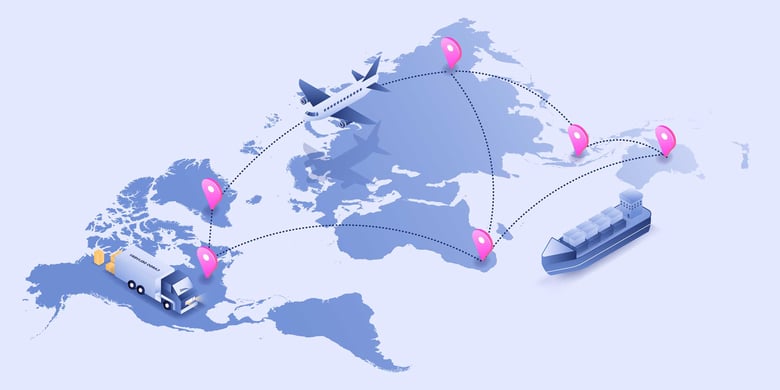We finally made it: 2020 has gone with the wind and it’s time to look forward into 2021 — and importantly, what e-commerce trends to look out for this year. And with just small, smart changes to your online store, you can stay ahead of key trends in the and thrive in an unpredictable world. To give you a headstart, we’ve wrapped up three of 2021’s most impactful e-commerce trends below — and how you can capitalise them in your business.
Trend 1: Increased competition in the digital sphere
Shopify's annual The Future of E-commerce 2021 report anticipates that the e-commerce boom will fuel record high online competition. The e-commerce market continues to grow in 2021 and 2022, which will inevitably drive up customer acquisition costs. Not everyone is equipped to compete on customer experience, which gives a competitive edge to brands with an immersive omnichannel experience.

What can you do?
To put it simply: make sure the customer experience in your online store is top-notch.
Keep in mind that the customer experience is not just about clicks, scrolls, and add to shopping cart button colors. It's the whole thing. It's the journey from advertising to getting the customer to your online store, from the buying process to interacting with your customer service, from communicating the delivery status timely to delivering the product to your customer's doorstep.
Shopify emphasizes that when considering order fulfillment, today's brands should make sure to deliver value through these four cornerstones.
Shipping should be:
- fast
- free
- sustainable
- branded
E-commerce order fulfillment is an area where e-commerce businesses can achieve a lot or on the other hand, lose a lot. An e-commerce specialized professional 3PL partner may be just the right solution if you want to streamline processes, gain cost-efficiency, and have the flexibility that helps you stay on top of the competition.
Read how to make e-commerce order fulfillment your competitive advantage.
Trend 2: Demand for sustainability
It’s not news that the online consumer is becoming increasingly environmentally conscious. The above mentioned Shopify's Future of Ecommerce 2021 report states that the percentage of consumers who want brands to be socially responsible is 41.8%. And according to the same report, consumers are more inclined to buy from companies with a reputation for environmental responsibility.

What can you do?
Zero-waste packaging or reduced package sizes are some of the answers e-commerce merchants can give to meet the sustainability demands.
OGOship’s approach is, in addition to offering sustainable packaging options, to optimize and to reduce shipping route lengths. And it’s easily achieved by multi-warehousing: storing the goods in multiple warehouses at the same time. It's a triple-win situation, really: with shorter shipping routes, the shipments are delivered faster, cheaper, and with a lower carbon footprint.
Let’s take an example:
In this example, we’ll compare shipments from a warehouse in Tallinn, Estonia, and Venlo in the Netherlands. The package weighs 1 kg. The customer is located in Frankfurt am Main, Germany. The prices and times are actual OGOship prices and shipping times.
A. Air freight from a warehouse in Tallinn, Estonia.
The distance between the warehouse and the customer is 1583 kilometers. The shipment costs 6,19€ and takes 3-4 days. C02 emission is 19,52 kgC02e(WtW).
B. Road freight from a warehouse in Venlo, the Netherlands.
The distance between the warehouse and the customer is 285 kilometers. The shipment costs 3,5€ and takes 24 hours. C02 emission is 2,64kgC02e(WtW).
The results: If you ship the package using air freight from Tallinn, the C02 emission is 98% higher compared to road freight from Venlo. Road freight from Venlo takes 75% less time and is 40% cheaper.
The point is, it’s a no-brainer to use multi-warehousing and ship from the closest possible location to save time, money, and the environment.
Trend 3: Multi-channel e-commerce
Multi-channel e-commerce has been around for a while. Still, with e-commerce giants like Amazon expanding to new markets, the multi-channel approach likely continues to be a compelling alternative for online merchants in the future too.
Multi-channel e-commerce means that online merchants sell products across multiple marketplaces and platforms, rather than just their website. Keep in mind though, that managing multi-channel sales can become a mess if not handled properly.

What can you do?
To operate multi-channel e-commerce successfully, you need to:
- Ensure you have the right tools that help you manage to sell in the channels you prefer
- Find out if your current toolset allows you to connect multiple stores, marketplaces, or platforms to the same inventory
- Evaluate if you need additional software that enables you to execute multi-channel sales.
OGOship's Order Management System myOGO allows OGOship customers to connect as many sales channels to the inventory as they need, with simple and cost-free integrations. So, if you want to explore selling on Amazon but use our 3PL services, you can. This is all included to our services, you don't need to worry about hidden costs or extra fees.
So if you’re ready to beat the competition, operate your business more sustainably and diversify into multi-channel e-commerce — we’re ready to help.
Get in touch with one of our friendly e-commerce experts to find out more!
Tags:
E-commerce growth

